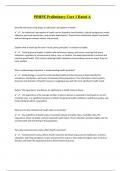PDHPE Preliminary Core 1 Rated A
Describe the factors that shape an individual’s perception of health.
✔️✔️ An individual's perception of health can be shaped by family beliefs, cultural background, media
influence, personal experiences, and societal expectations. These factors collectively impact how health
and well-being are viewed, valued, and pursued.
Explain what is meant by the term “social justice principles” in relation to health.
✔️✔️ Social justice principles in health refer to fairness, equity, and access, ensuring that every
individual, regardless of socioeconomic status, race, or location, has equal opportunity to achieve and
maintain good health. This involves reducing health inequities and providing resources where they are
most needed.
Why is epidemiology important in understanding health priorities?
✔️✔️ Epidemiology is crucial for understanding health priorities because it helps identify the
prevalence, distribution, and causes of diseases within populations. This information informs policy
decisions and allocation of health resources, targeting areas with the most significant health needs.
Define “life expectancy” and discuss its significance in health status analysis.
✔️✔️ Life expectancy is the average number of years a person is expected to live based on current
mortality rates. It is significant because it reflects the general health conditions, healthcare quality, and
living standards within a population.
What are the key indicators of health status in Australia?
✔️✔️ Key indicators of health status in Australia include mortality rates, morbidity rates, life
expectancy, infant mortality, and self-reported health status. These indicators provide insights into the
overall health and well-being of the population.
How does socioeconomic status affect health outcomes?
✔️✔️ Socioeconomic status affects health outcomes by influencing access to healthcare, nutrition,
education, and living conditions. Lower socioeconomic status is often linked to higher rates of chronic
diseases and lower life expectancy due to these limited resources.
, Discuss how age and gender impact health needs and priorities.
✔️✔️ Age and gender impact health needs and priorities by determining vulnerability to specific
conditions. For instance, older individuals may require more healthcare for chronic illnesses, while
young adults often focus on mental health and lifestyle-related diseases. Gender differences also
influence health risks and outcomes, such as reproductive health needs in women and higher risk
behaviors in men.
What role do the determinants of health (individual, sociocultural, socioeconomic, and environmental)
play in shaping health behaviors?
✔️✔️ Determinants of health influence behaviors by shaping an individual’s access, motivation, and
ability to pursue healthy choices. For example, socioeconomic status can affect access to nutritious food,
while sociocultural factors may affect attitudes towards exercise and wellness.
Explain the role of the government in reducing health inequities in Australia.
✔️✔️ The government plays a crucial role in reducing health inequities by implementing policies,
funding public health programs, and promoting preventive healthcare. Initiatives like Medicare, health
campaigns, and support for marginalized groups are examples of government efforts to achieve health
equity.
Identify and explain one health issue that affects young people in Australia.
✔️✔️ Mental health is a significant issue affecting young people in Australia, with rising rates of
anxiety and depression. Factors such as academic pressure, social media influence, and lifestyle changes
contribute to this concern, making mental health support essential for this age group.
Describe how modifiable health behaviors can reduce the risk of chronic disease.
✔️✔️ Modifiable health behaviors, like maintaining a balanced diet, regular exercise, and avoiding
tobacco, can significantly reduce the risk of chronic diseases such as heart disease, diabetes, and cancer.
These behaviors promote a healthier lifestyle and enhance overall well-being.
What are the main objectives of the Ottawa Charter for Health Promotion?
✔️✔️ The Ottawa Charter for Health Promotion aims to build healthy public policy, create supportive
environments, strengthen community action, develop personal skills, and reorient health services. These
objectives focus on empowering individuals and communities to improve health and well-being.




